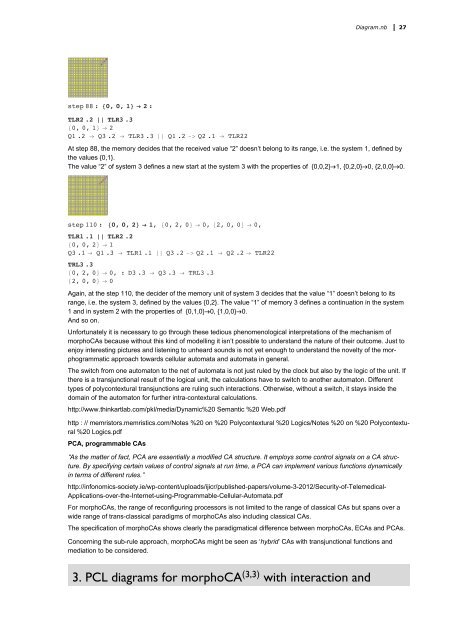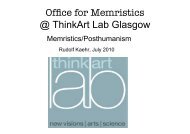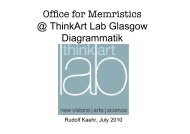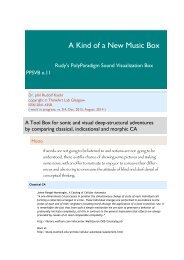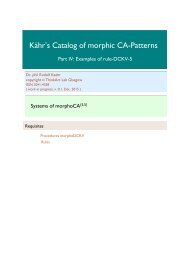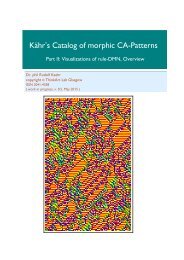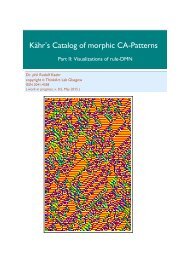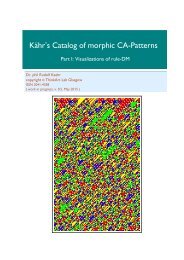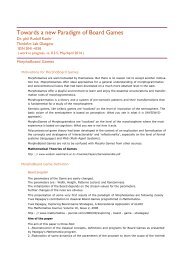Metaphors of Dissemination and Interaction of morphoCAs
Meta-theoretical considerations about the behavior of morphic cellular automata are sketched. Different types of flow diagrams for morphoCAs are distinguished: 1. mono-contextural, 2. interactional/transactional and 3. mediational poly-contextural types. Those thematizations are offering a better understanding of the nature of morphic cellular automata.
Meta-theoretical considerations about the behavior of morphic cellular automata are sketched. Different types of flow diagrams for morphoCAs are distinguished: 1. mono-contextural, 2. interactional/transactional and 3. mediational poly-contextural types. Those thematizations are offering a better understanding of the nature of morphic cellular automata.
Create successful ePaper yourself
Turn your PDF publications into a flip-book with our unique Google optimized e-Paper software.
Diagram.nb 27<br />
step 88 : {0, 0, 1} → 2 :<br />
TLR2 .2 || TLR3 .3<br />
{0, 0, 1} → 2<br />
Q1 .2 → Q3 .2 → TLR3 .3 || Q1 .2 -> Q2 .1 → TLR22<br />
At step 88, the memory decides that the received value “2” doesn’t belong to its range, i.e. the system 1, defined by<br />
the values {0,1}.<br />
The value “2” <strong>of</strong> system 3 defines a new start at the system 3 with the properties <strong>of</strong> {0,0,2}→1, {0,2,0}→0, {2,0,0}→0.<br />
step 110 : {0, 0, 2} → 1, {0, 2, 0} → 0, {2, 0, 0} → 0,<br />
TLR1 .1 || TLR2 .2<br />
{0, 0, 2} → 1<br />
Q3 .1 → Q1 .3 → TLR1 .1 || Q3 .2 -> Q2 .1 → Q2 .2 → TLR22<br />
TRL3 .3<br />
{0, 2, 0} → 0, : D3 .3 → Q3 .3 → TRL3 .3<br />
{2, 0, 0} → 0<br />
Again, at the step 110, the decider <strong>of</strong> the memory unit <strong>of</strong> system 3 decides that the value “1” doesn’t belong to its<br />
range, i.e. the system 3, defined by the values {0,2}. The value “1” <strong>of</strong> memory 3 defines a continuation in the system<br />
1 <strong>and</strong> in system 2 with the properties <strong>of</strong> {0,1,0}→0, {1,0,0}→0.<br />
And so on.<br />
Unfortunately it is necessary to go through these tedious phenomenological interpretations <strong>of</strong> the mechanism <strong>of</strong><br />
<strong>morphoCAs</strong> because without this kind <strong>of</strong> modelling it isn’t possible to underst<strong>and</strong> the nature <strong>of</strong> their outcome. Just to<br />
enjoy interesting pictures <strong>and</strong> listening to unheard sounds is not yet enough to underst<strong>and</strong> the novelty <strong>of</strong> the morphogrammatic<br />
approach towards cellular automata <strong>and</strong> automata in general.<br />
The switch from one automaton to the net <strong>of</strong> automata is not just ruled by the clock but also by the logic <strong>of</strong> the unit. If<br />
there is a transjunctional result <strong>of</strong> the logical unit, the calculations have to switch to another automaton. Different<br />
types <strong>of</strong> polycontextural transjunctions are ruling such interactions. Otherwise, without a switch, it stays inside the<br />
domain <strong>of</strong> the automaton for further intra-contextural calculations.<br />
http://www.thinkartlab.com/pkl/media/Dynamic%20 Semantic %20 Web.pdf<br />
http : // memristors.memristics.com/Notes %20 on %20 Polycontextural %20 Logics/Notes %20 on %20 Polycontextural<br />
%20 Logics.pdf<br />
PCA, programmable CAs<br />
“As the matter <strong>of</strong> fact, PCA are essentially a modified CA structure. It employs some control signals on a CA structure.<br />
By specifying certain values <strong>of</strong> control signals at run time, a PCA can implement various functions dynamically<br />
in terms <strong>of</strong> different rules.”<br />
http://infonomics-society.ie/wp-content/uploads/ijicr/published-papers/volume-3-2012/Security-<strong>of</strong>-Telemedical-<br />
Applications-over-the-Internet-using-Programmable-Cellular-Automata.pdf<br />
For <strong>morphoCAs</strong>, the range <strong>of</strong> reconfiguring processors is not limited to the range <strong>of</strong> classical CAs but spans over a<br />
wide range <strong>of</strong> trans-classical paradigms <strong>of</strong> <strong>morphoCAs</strong> also including classical CAs.<br />
The specification <strong>of</strong> <strong>morphoCAs</strong> shows clearly the paradigmatical difference between <strong>morphoCAs</strong>, ECAs <strong>and</strong> PCAs.<br />
Concerning the sub-rule approach, <strong>morphoCAs</strong> might be seen as ‘hybrid’ CAs with transjunctional functions <strong>and</strong><br />
mediation to be considered.<br />
3. PCL diagrams for morphoCA (3,3) with interaction <strong>and</strong><br />
mediation


